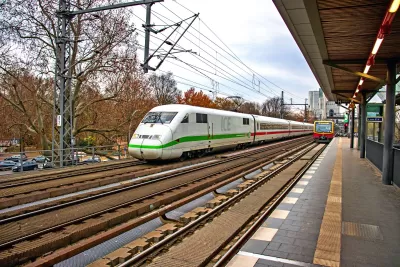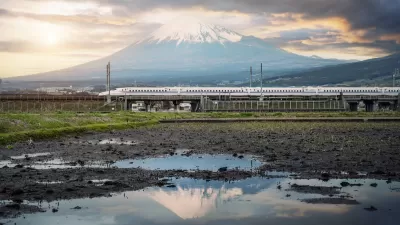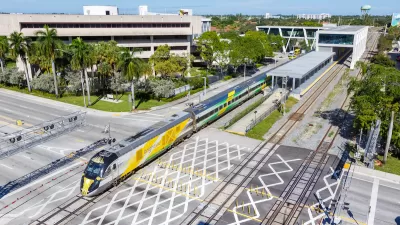If completed, the North Atlantic Rail project could transform New England's transportation landscape.

A proposed high-speed rail megaproject would connect New York and Boston via Hartford and Providence, promising a faster commute for the region's millions of workers. Anthony Flint reports on the project for Bloomberg CityLab.
The private backers of the North Atlantic Rail Project hope to attract President "Amtrak Joe" Biden's attention and federal investment, claiming that their project "checks all the boxes for a multi-benefit recovery strategy." NAR promises to cut travel time between New York and Boston down to 100 minutes, two hours shorter than Amtrak's current service. The project's supporters say it would benefit not only residents of Boston and New York but also those in the "left-behind, post-industrial legacy cities" between the two, which could see an influx of new investment and development if they become accessible by high-speed rail.
In the final phase, the NAR network would add more stops in smaller cities, making it easier for people to travel throughout the region and potentially easing housing affordability issues. Hartford mayor Luke Bronin, co-chair of the North Atlantic Rail initiative, said the new connections "would unlock economic opportunity and spur growth for dozens of mid-sized cities throughout New England, connecting the entire region in one integrated market for ideas, labor and innovation."
One major hiccup could be the project's $105-billion price tag, with the massive cost due in part to the engineering challenges faced in building and tunneling in densely developed areas and underwater. When compared to other projects around the world, however, NAR would be a small step in bringing the United States closer to having a world-class transportation system.
FULL STORY: Is This High-Speed Train the First Megaproject of the Biden Era?

Manufactured Crisis: Losing the Nation’s Largest Source of Unsubsidized Affordable Housing
Manufactured housing communities have long been an affordable housing option for millions of people living in the U.S., but that affordability is disappearing rapidly. How did we get here?

Americans May Be Stuck — But Why?
Americans are moving a lot less than they once did, and that is a problem. While Yoni Applebaum, in his highly-publicized article Stuck, gets the reasons badly wrong, it's still important to ask: why are we moving so much less than before?

Using Old Oil and Gas Wells for Green Energy Storage
Penn State researchers have found that repurposing abandoned oil and gas wells for geothermal-assisted compressed-air energy storage can boost efficiency, reduce environmental risks, and support clean energy and job transitions.

Updating LA’s Tree Rules Could Bring More Shade to Underserved Neighborhoods
A new USC study finds that relaxing Los Angeles’ outdated tree planting guidelines could significantly expand urban tree canopy and reduce shade disparities in lower-income neighborhoods, though infrastructure investments are also needed.

California's Canal Solar Projects Aim to Conserve Resources and Expand Clean Energy
California’s Project Nexus has begun generating electricity from solar panels installed over irrigation canals, with researchers and state agencies exploring statewide expansion to conserve water and boost clean energy production.

HHS Staff Cuts Gut Energy Assistance Program
The full staff of a federal program that distributes heating and cooling assistance for low-income families was laid off, jeopardizing the program’s operations.
Urban Design for Planners 1: Software Tools
This six-course series explores essential urban design concepts using open source software and equips planners with the tools they need to participate fully in the urban design process.
Planning for Universal Design
Learn the tools for implementing Universal Design in planning regulations.
Heyer Gruel & Associates PA
City of Moreno Valley
Institute for Housing and Urban Development Studies (IHS)
City of Grandview
Harvard GSD Executive Education
Salt Lake City
NYU Wagner Graduate School of Public Service
City of Cambridge, Maryland





























